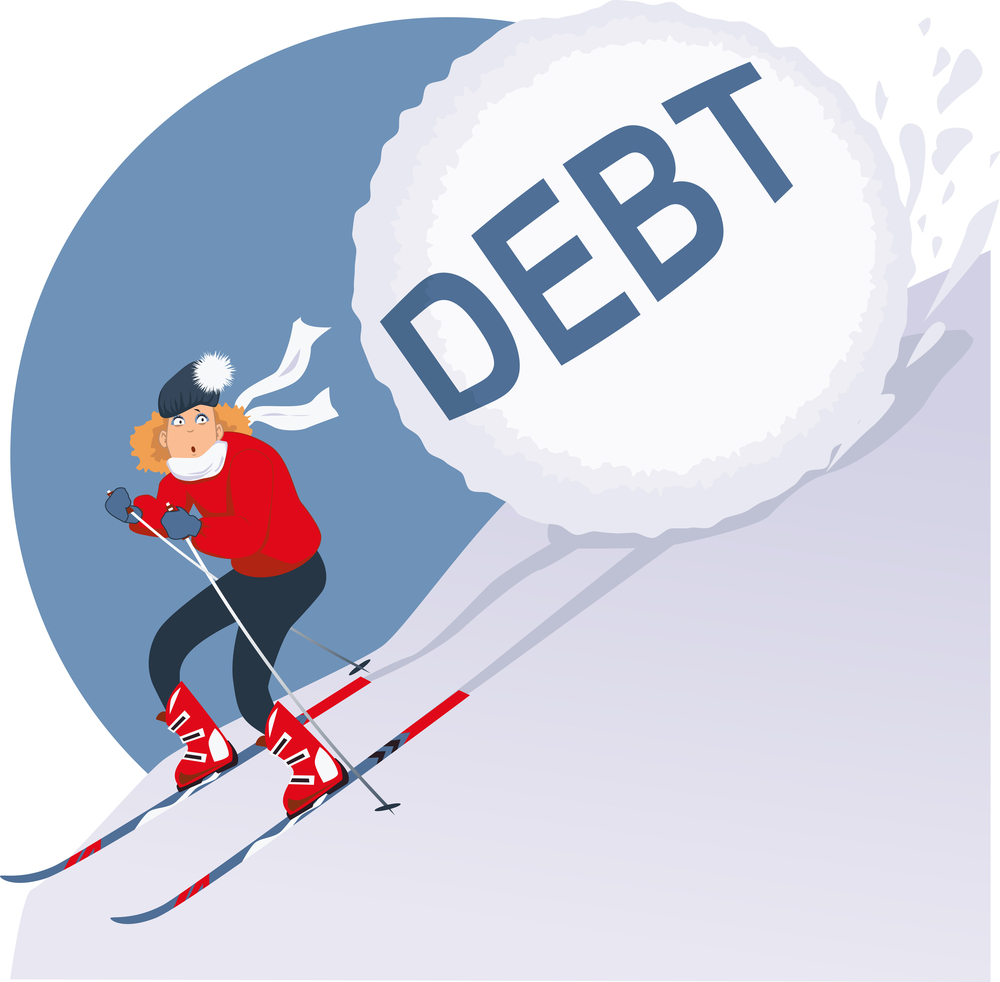Editorial Note: We earn a commission from partner links on Doughroller. Commissions do not affect our authors’ or editors’ opinions or evaluations. Learn more here.
The debt avalanche is the fastest and cheapest way to pay off your debts. But is it always the best way? Sometimes the debt snowball may be better. In this article, we’ll compare the debt avalanche vs. the debt snowball.
When it comes to math, things are pretty straightforward. No matter what language you speak, one and one always equals two. And, in theory, finances should work this way, too. After all, money is based on math.
Ah, but here is where we run into a problem. Because money isn’t just about math. It’s also about a host of human factors, including our emotions, unexpected circumstances, and even our physical state. Have you ever tried to spend less at the grocery store when you’re hungry? You know what I mean!

This is why experts argue about the best ways to pay off debts. There is actually a mathematically correct way to pay off debt. It’s known, typically, as the debt avalanche. If you stick to it, the debt avalanche is definitely more efficient and faster than the debt snowball popularized by Dave Ramsey.
But following the debt avalanche, even though it’s the “correct” way to pay off debts, isn’t always the best option. First, let’s talk about what the debt avalanche actually is. Then, we’ll talk about when it might not be the best option.
What is a Debt Avalanche?
You probably have already heard about the debt snowball if you’ve read anything in the personal finance space. It’s the idea that when paying off your debts, you should start with the smallest balance debt first. Once you pay off that debt, you put extra money plus that debt’s monthly minimum payment towards your next smallest debt, and so on.
The idea here is that you get a quick win up front by paying off one or two of your smaller debts quickly. This approach doesn’t account for interest rates at all.
The debt avalanche, on the other hand, is all about interest rates. Here’s how to do it:
1. Order your debts from highest to lowest interest rate. Oftentimes, your credit cards will be at the top of the list with their exorbitant interest rates. But you’re not worried about a provider or loan servicer. Only the interest rate you’re currently paying counts.
What should you do about introductory rates? It depends. You might decide to pay only the minimum until the interest rate goes up.
For instance, say you’re currently paying 0% interest on a credit card. In 15 months, the interest rate will jump to 17.99%. Right now, just leave the card at the bottom of your to-be-paid list. That’s where it belongs with that introductory interest rate. Just pay attention to when the interest rate rises. Then, you may need to reorder your debt payoff plan to account for the card’s increased interest rate.
2. Pay the minimum on all of your debts each month. This is essential. If you can’t pay more than the minimum, at least pay that.
3. Put any extra money towards the highest interest debt first. Don’t think you can find any extra money? Check out this list of ways to start paying off debt today. Whatever extra you can scrape together or pull out of your budget goes towards this debt, even if it’s the largest balance debt on your list.
4. Repeat every month. Eventually, you’ll pay off that first debt. Once you do, move towards putting extra money–plus that first debt’s minimum payment–towards the second-highest interest rate debt on your list.
It’s really pretty straightforward. The only thing that makes it different from the debt snowball is the order in which you pay off your debts. So what’s the difference, mathematically, and why is the debt avalanche not always the best method to use, even though it’s the most efficient? First, the math.
Debt Avalanche vs. The Debt Snowball
If you know anything at all about basic math and interest rates, it’s not hard to surmise that the debt avalanche will be the more efficient option for paying off debts. When you pay down the principal on your highest-interest debts first, you pay less interest overall. And since you’re paying less overall interest, you’ll pay off your debts faster. Sometimes, the difference is significant, but sometimes it’s not.
Let’s say you have the following debts:
- Credit Card one: $2,500 balance; $70 minimum payment; 18.99% interest rate
- Credit Card two: $1,000 balance; $25 minimum payment; 10.00% interest rate
- Student Loan: $15,000 balance; $150 minimum payment; 8.99% interest rate
- Car Loan: $8,000 balance: $250 minimum payment; 10.00% interest rate
With a debt snowball, you’d pay off your debts in this order:
- Credit Card two
- Credit Card one
- Car Loan
- Student Loan
With a debt avalanche, you’d paid them in this order:
- Credit Card 1
- Credit Card 2/Car Loan (your choice!)
- Student Loan.
Since there’s not much difference in order, there’s also not much difference in outcome. If you pay $1,000 per month total towards your debts, you’ll pay them off in 30 months either way. You’ll pay $3,347 in interest with the debt snowball and $3,309 with the avalanche.
So the debt avalanche saves you money, but not a ton. This is generally going to be the case if the method you choose won’t dramatically alter the order in which you pay off your debts.
But what if the method did make a big difference? Let’s look at another scenario.
- Credit Card one: $7,500 balance; $150 minimum payment; 18.99% interest rate
- Credit Card two: $500 balance; $25 minimum payment; 9.99% interest rate
- Student Loan: $15,000 balance; $150 minimum payment; 10.00% interest rate
- Car Loan: $8,000 balance; $250 minimum payment; 12.o0% interest rate
So under a debt snowball, you’d pay them in this order:
- Credit Card two
- Credit Card one
- Car Loan
- Student Loan
Under a debt avalanche, you use this order:
- Credit Card one
- Car Loan
- Credit Card two
- Student Loan.
Let’s also say that money is tight, and you can only put $600 a month towards your debts. In this case, it would still take you the same amount of time to pay them off–74 months. But you’d pay $13,367 in interest with the debt snowball and just $13,143 in interest with the avalanche.
The bottom line here is that these differences will amplify with a bigger spread in interest rates, a larger overall balance, or a longer time taken to pay off your debts. But unless you have huge amounts of debt, the difference may not add up to more than a few hundred bucks in interest.
So is the Debt Avalanche Really Best?
Here’s the bottom line. The math will always come out in favor of the debt avalanche method. But that doesn’t mean it’s the best method for paying off your debts. In fact, research shows that for most people, the debt snowball method is more motivating and more effective. There’s a reason, after all, Dave Ramsey’s program has been so successful over the years!
With that said, there are some other important factors to consider when making this decision, including:
Whether or not you can refinance your debts. If you have a good credit score, you may be able to move some of your debts around to much lower interest rates. This is a good move, as long as you don’t use those freed-up credit card limits to rack up even more debt. Refinancing through 0% introductory APR credit cards or personal loans can help even out the math with super high-interest debt.
Here’s a list of some lenders to consider:
|
How you drive your financial decision making. If you’re like most people, your money decisions are driven more by emotions than you’d like to admit. Even if you consider yourself a logic-driven person, it’s hard to remove emotion completely from your spending and saving choices. So take this into account, and be honest with yourself. If small wins up front will keep you motivated to pay off your debts, use the debt snowball. If you can stay the course regardless, try the debt avalanche.
Your actual interest rate situation. If you have one debt that has an incredibly high interest rate, while the rest are more average, it’s probably best to pay off that debt first. If you can’t refinance it, just push through and pay it off–even if its balance isn’t as low as some of your other debts. This will free up more money to keep pushing on with getting out of debt, too.
So remember, the debt avalanche is the mathematically correct way to pay off your debts. But that doesn’t mean it’s the only answer. The important thing is that you continue making payments on your debts so that you work towards becoming debt-free.


